suspension Alfa Romeo Giulietta 2014 Owner's Manual
[x] Cancel search | Manufacturer: ALFA ROMEO, Model Year: 2014, Model line: Giulietta, Model: Alfa Romeo Giulietta 2014Pages: 280, PDF Size: 6.65 MB
Page 2 of 280
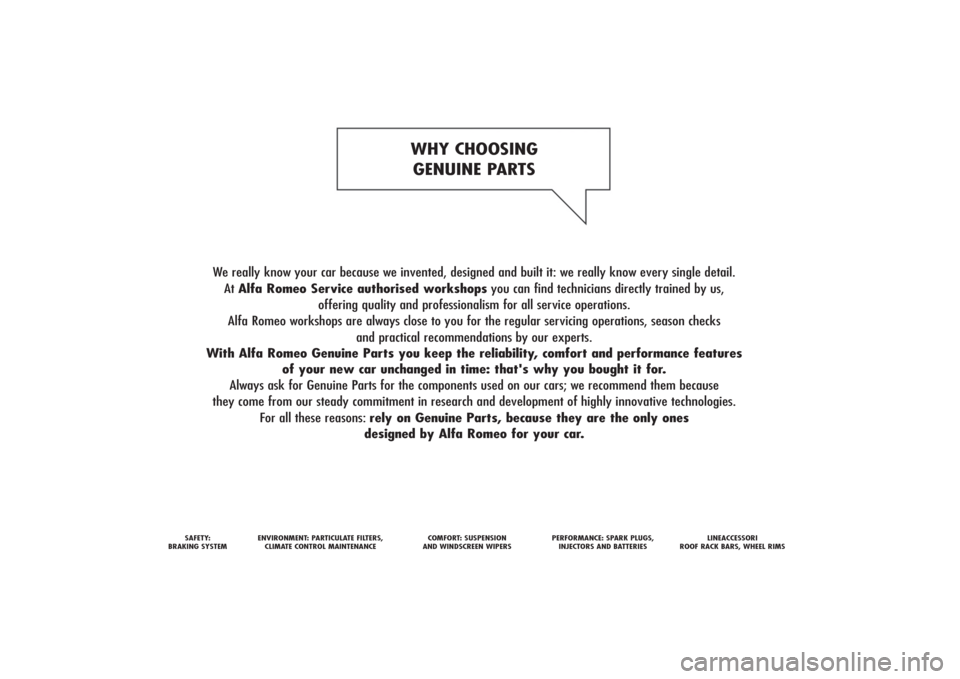
We really know your car because we invented, designed and built it: we really know every single detail.
At Alfa Romeo Service authorised workshopsyou can find technicians directly trained by us,
offering quality and professionalism for all service operations.
Alfa Romeo workshops are always close to you for the regular servicing operations, season checks
and practical recommendations by our experts.
With Alfa Romeo Genuine Parts you keep the reliability, comfort and performance features
of your new car unchanged in time: that's why you bought it for.
Always ask for Genuine Parts for the components used on our cars; we recommend them because
they come from our steady commitment in research and development of highly innovative technologies.
For all these reasons: rely on Genuine Parts, because they are the only ones
designed by Alfa Romeo for your car.
SAFETY:
BRAKING SYSTEM
ENVIRONMENT: PARTICULATE FILTERS,
CLIMATE CONTROL MAINTENANCE
COMFORT: SUSPENSION
AND WINDSCREEN WIPERS
PERFORMANCE: SPARK PLUGS,
INJECTORS AND BATTERIES
LINEACCESSORI
ROOF RACK BARS, WHEEL RIMS
WHY CHOOSING
GENUINE PARTS
Page 71 of 280
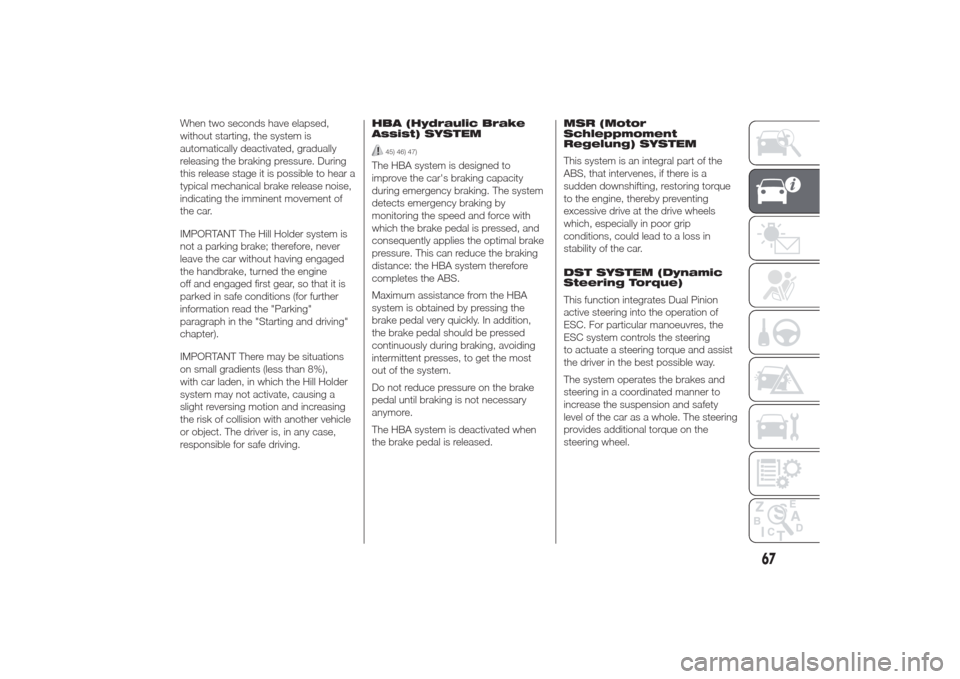
When two seconds have elapsed,
without starting, the system is
automatically deactivated, gradually
releasing the braking pressure. During
this release stage it is possible to hear a
typical mechanical brake release noise,
indicating the imminent movement of
the car.
IMPORTANT The Hill Holder system is
not a parking brake; therefore, never
leave the car without having engaged
the handbrake, turned the engine
off and engaged first gear, so that it is
parked in safe conditions (for further
information read the "Parking"
paragraph in the "Starting and driving"
chapter).
IMPORTANT There may be situations
on small gradients (less than 8%),
with car laden, in which the Hill Holder
system may not activate, causing a
slight reversing motion and increasing
the risk of collision with another vehicle
or object. The driver is, in any case,
responsible for safe driving.HBA (Hydraulic Brake
Assist) SYSTEM
45) 46) 47)
The HBA system is designed to
improve the car's braking capacity
during emergency braking. The system
detects emergency braking by
monitoring the speed and force with
which the brake pedal is pressed, and
consequently applies the optimal brake
pressure. This can reduce the braking
distance: the HBA system therefore
completes the ABS.
Maximum assistance from the HBA
system is obtained by pressing the
brake pedal very quickly. In addition,
the brake pedal should be pressed
continuously during braking, avoiding
intermittent presses, to get the most
out of the system.
Do not reduce pressure on the brake
pedal until braking is not necessary
anymore.
The HBA system is deactivated when
the brake pedal is released.MSR (Motor
Schleppmoment
Regelung) SYSTEM
This system is an integral part of the
ABS, that intervenes, if there is a
sudden downshifting, restoring torque
to the engine, thereby preventing
excessive drive at the drive wheels
which, especially in poor grip
conditions, could lead to a loss in
stability of the car.
DST SYSTEM (Dynamic
Steering Torque)
This function integrates Dual Pinion
active steering into the operation of
ESC. For particular manoeuvres, the
ESC system controls the steering
to actuate a steering torque and assist
the driver in the best possible way.
The system operates the brakes and
steering in a coordinated manner to
increase the suspension and safety
level of the car as a whole. The steering
provides additional torque on the
steering wheel.
67
Page 88 of 280
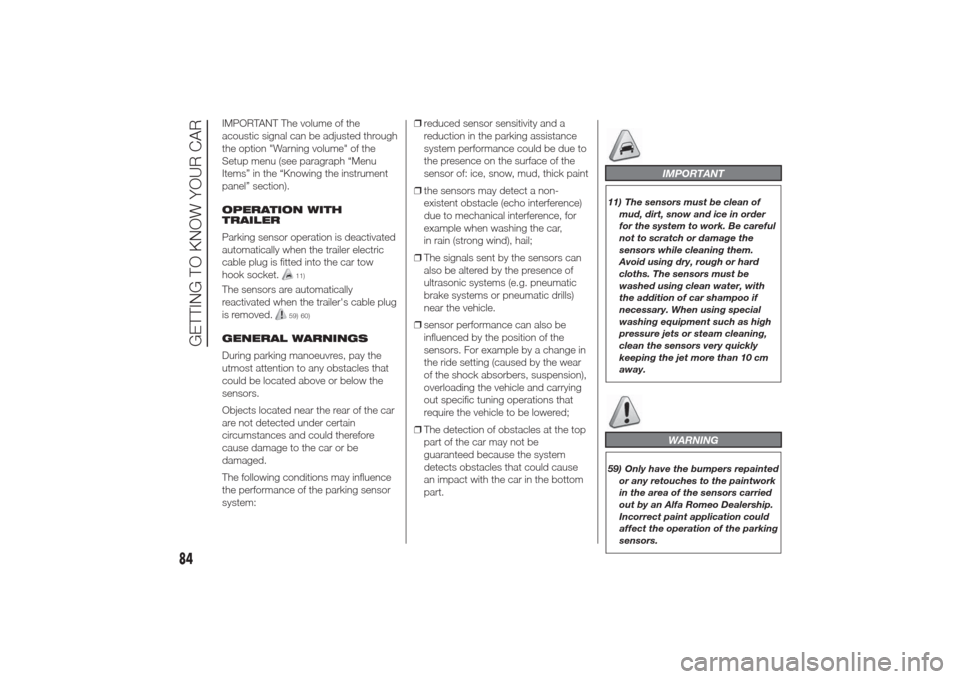
IMPORTANT The volume of the
acoustic signal can be adjusted through
the option "Warning volume" of the
Setup menu (see paragraph “Menu
Items” in the “Knowing the instrument
panel” section).
OPERATION WITH
TRAILER
Parking sensor operation is deactivated
automatically when the trailer electric
cable plug is fitted into the car tow
hook socket.
11)
The sensors are automatically
reactivated when the trailer's cable plug
is removed.
59) 60)
GENERAL WARNINGS
During parking manoeuvres, pay the
utmost attention to any obstacles that
could be located above or below the
sensors.
Objects located near the rear of the car
are not detected under certain
circumstances and could therefore
cause damage to the car or be
damaged.
The following conditions may influence
the performance of the parking sensor
system:❒reduced sensor sensitivity and a
reduction in the parking assistance
system performance could be due to
the presence on the surface of the
sensor of: ice, snow, mud, thick paint
❒the sensors may detect a non-
existent obstacle (echo interference)
due to mechanical interference, for
example when washing the car,
in rain (strong wind), hail;
❒The signals sent by the sensors can
also be altered by the presence of
ultrasonic systems (e.g. pneumatic
brake systems or pneumatic drills)
near the vehicle.
❒sensor performance can also be
influenced by the position of the
sensors. For example by a change in
the ride setting (caused by the wear
of the shock absorbers, suspension),
overloading the vehicle and carrying
out specific tuning operations that
require the vehicle to be lowered;
❒The detection of obstacles at the top
part of the car may not be
guaranteed because the system
detects obstacles that could cause
an impact with the car in the bottom
part.
IMPORTANT
11) The sensors must be clean of
mud, dirt, snow and ice in order
for the system to work. Be careful
not to scratch or damage the
sensors while cleaning them.
Avoid using dry, rough or hard
cloths. The sensors must be
washed using clean water, with
the addition of car shampoo if
necessary. When using special
washing equipment such as high
pressure jets or steam cleaning,
clean the sensors very quickly
keeping the jet more than 10 cm
away.
WARNING
59) Only have the bumpers repainted
or any retouches to the paintwork
in the area of the sensors carried
out by an Alfa Romeo Dealership.
Incorrect paint application could
affect the operation of the parking
sensors.
84
GETTING TO KNOW YOUR CAR
Page 227 of 280
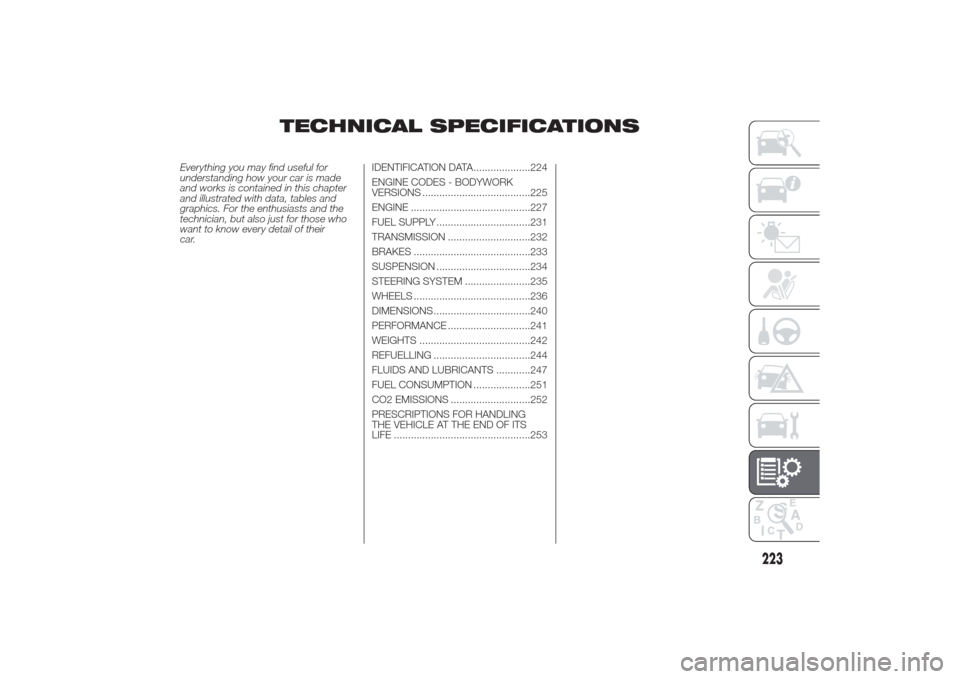
TECHNICAL SPECIFICATIONS
Everything you may find useful for
understanding how your car is made
and works is contained in this chapter
and illustrated with data, tables and
graphics. For the enthusiasts and the
technician, but also just for those who
want to know every detail of their
car.IDENTIFICATION DATA....................224
ENGINE CODES - BODYWORK
VERSIONS ......................................22
ENGINE ..........................................227
FUEL SUPPLY .................................231
TRANSMISSION .............................232
BRAKES .........................................233
SUSPENSION .................................23
STEERING SYSTEM .......................235
WHEELS .........................................236
DIMENSIONS ..................................240
PERFORMANCE .............................241
WEIGHTS .......................................242
REFUELLING ..................................244
FLUIDS AND LUBRICANTS ............247
FUEL CONSUMPTION ....................25
CO2 EMISSIONS ............................252
PRESCRIPTIONS FOR HANDLING
THE VEHICLE AT THE END OF ITS
LIFE ................................................253
223
5
4
1
Page 238 of 280
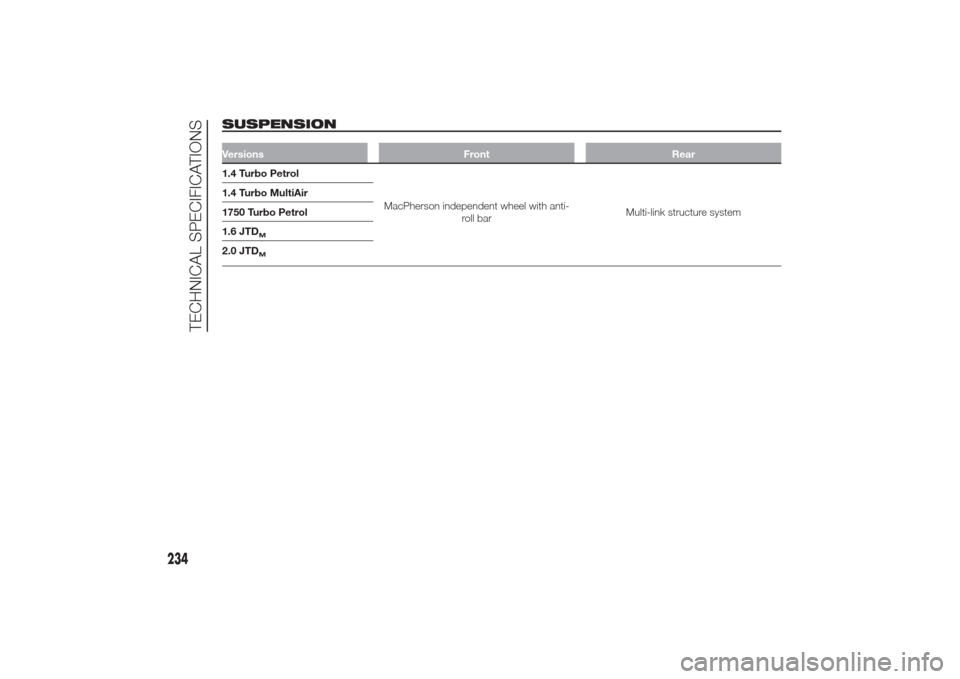
SUSPENSIONVersions Front Rear1.4 Turbo Petrol
MacPherson independent wheel with anti-
roll barMulti-link structure system 1.4 Turbo MultiAir
1750 Turbo Petrol
1.6 JTD
M
2.0 JTD
M
234
TECHNICAL SPECIFICATIONS
Page 277 of 280
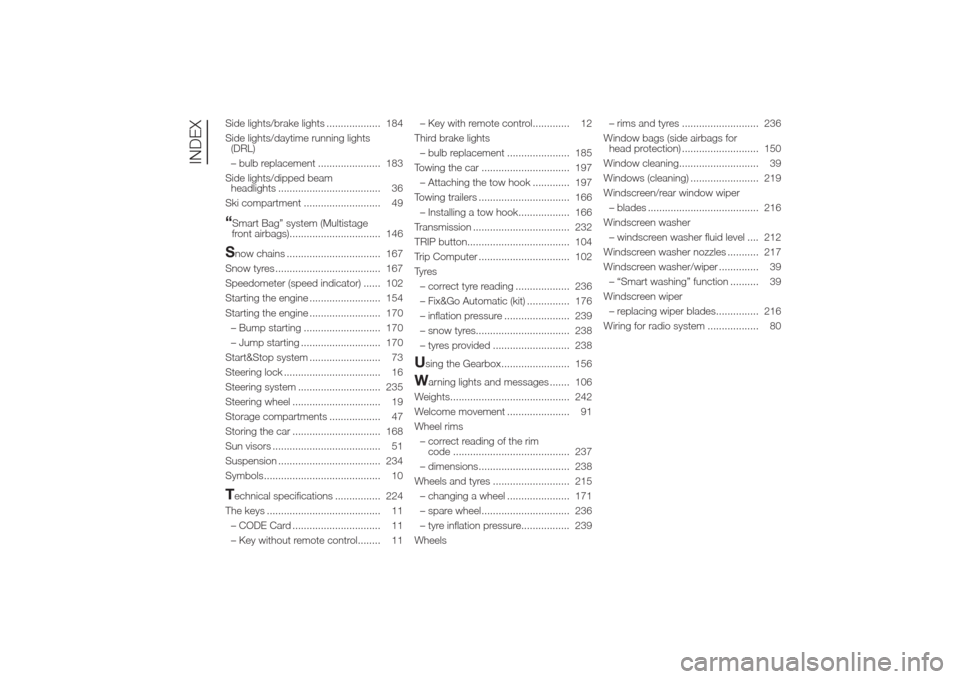
Side lights/brake lights ................... 184
Side lights/daytime running lights
(DRL)
– bulb replacement ...................... 183
Side lights/dipped beam
headlights .................................... 36
Ski compartment ........................... 49“Smart Bag” system (Multistage
front airbags)................................ 146Snow chains ................................. 167
Snow tyres ..................................... 167
Speedometer (speed indicator) ...... 102
Starting the engine ......................... 154
Starting the engine ......................... 170
– Bump starting ........................... 170
– Jump starting ............................ 170
Start&Stop system ......................... 73
Steering lock .................................. 16
Steering system ............................. 235
Steering wheel ............................... 19
Storage compartments .................. 47
Storing the car ............................... 168
Sun visors ...................................... 51
Suspension .................................... 234
Symbols......................................... 10Technical specifications ................ 224
The keys ........................................ 11
– CODE Card ............................... 11
– Key without remote control........ 11– Key with remote control............. 12
Third brake lights
– bulb replacement ...................... 185
Towing the car ............................... 197
– Attaching the tow hook ............. 197
Towing trailers ................................ 166
– Installing a tow hook.................. 166
Transmission .................................. 232
TRIP button.................................... 104
Trip Computer ................................ 102
Ty r e s
– correct tyre reading ................... 236
– Fix&Go Automatic (kit) ............... 176
– inflation pressure ....................... 239
– snow tyres................................. 238
– tyres provided ........................... 238
Using the Gearbox........................ 156W
arning lights and messages ....... 106
Weights.......................................... 242
Welcome movement ...................... 91
Wheel rims
– correct reading of the rim
code ......................................... 237
– dimensions................................ 238
Wheels and tyres ........................... 215
– changing a wheel ...................... 171
– spare wheel............................... 236
– tyre inflation pressure................. 239
Wheels– rims and tyres ........................... 236
Window bags (side airbags for
head protection) ........................... 150
Window cleaning............................ 39
Windows (cleaning) ........................ 219
Windscreen/rear window wiper
– blades ....................................... 216
Windscreen washer
– windscreen washer fluid level .... 212
Windscreen washer nozzles ........... 217
Windscreen washer/wiper .............. 39
– “Smart washing” function .......... 39
Windscreen wiper
– replacing wiper blades............... 216
Wiring for radio system .................. 80
INDEX